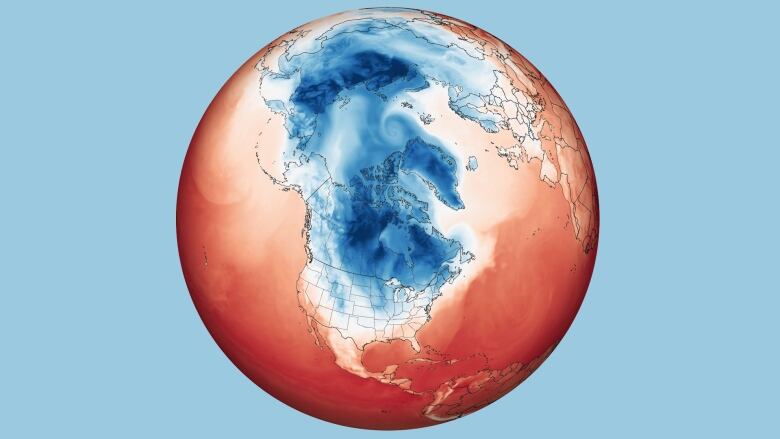How climate change is behind this week's extreme cold snap
With wind chill values, it could feel like 51 C in some parts of Canada and U.S.

Baby, it's frigid outside.
A large swath of Canada, from the Prairies to Nova Scotia, is under a deep freeze. Temperatures in Winnipeg are dipping down to 36 C Monday night with a windchill of almost 50 C. In Windsor, which is typically the warmest spot in Ontario, the overnight temperature will dip to 27 C witha windchill of 40 C.
Even in parts of the U.S. Midwest, temperatures are expected to have a wind chill of 50 C.
This may leave some, like U.S. president Donald Trump, wondering where global warming has wandered off to.
In the beautiful Midwest, windchill temperatures are reaching minus 60 degrees, the coldest ever recorded. In coming days, expected to get even colder. People cant last outside even for minutes. What the hell is going on with Global Waming? Please come back fast, we need you!
—@realDonaldTrumpThe fact is, it's climate change, or global warming, that's behindthis extreme cold.
Ever since the bitter winter of 2014, a new winter-weather catchphrase has been making the rounds: polar vortex.
The polar vortex is nothing new. It's just that it typicallyencircles the north pole. However, in recent years, it seems to be meandering southward every so often.
"This air mass always exists, and it often gets bumped and pushed around. In this case, the jet stream pushed it all the way down to the U.S. Midwest," said CBC meteorologist Johanna Wagstaffe. "Sometimes that air mass can get split, or divided because of the jet stream, so it ends up getting stuck in place."
That's what happened this week: the jet stream managed to split the descending polar vortex into three.
The jet stream
Though it's a relatively new area of study, there's increasing evidence that suggests this phenomenon will happen more often and become more extreme.
The key lies with thejet stream, a narrow, fast-moving band of air in our upper atmosphere that moves weather patterns around. In the past, the jet stream moved fairly smoothly around the northern hemisphere. But recently, it's developed more pronounced kinks that can bring cold, Arctic air much farther south than in the past, or bring heat from the Gulf of Mexico further north than has been typical.
And it's linked to the Arctic.

A recent Intergovernmental Panel on Climate Change report found the Arctic is warming two to three times faster than anywhere else on Earth. This temperature difference upsets the stability of thejet stream.
And that brings the cold Arctic air southward where it can linger, a result that meteorologists call a blocking pattern.
"We have seen more of these; we've noticed that trend already, that's proven. And all of our climate models show this trend will continue," Wagstaffe said. "And that doesn't just mean more heat and more drought conditions. It can also mean more of these extreme cold blasts or extreme wet or snowy systems staying in place longer than normal."
Climate vs. weather
The important thing to remember when discussing climate change is that climate and weather are two separate entities.
Weather is the state of the atmosphere pertaining to things like wind, moisture, temperature and more that occur on a day-to-day basis. Climate, on the other hand, is the average weather in one place over a long period of time.
Just because you step outside and the tears caused by bitter wind freeze on your cheeks, doesn't mean that climate change isn't happening.
In fact, at the same time much of Canada is in a deep freeze, other parts of the world are experiencing the opposite.
"The atmosphere is always trying to balance out its energy," Wagstaffe said. "So right now, on the other side of the globe, parts of northern Europe and northern Russia, they're actually experiencing record-breaking warm temperatures for this time of the year, and really close to the north pole."
Climate change isn't about what's happening today, but what's happening globally, over time.












_(720p).jpg)


 OFFICIAL HD MUSIC VIDEO.jpg)
.jpg)



























































































